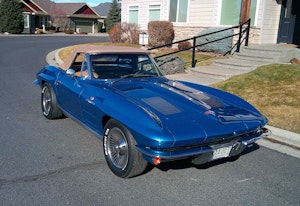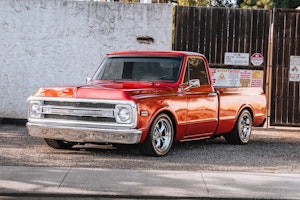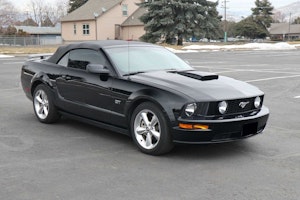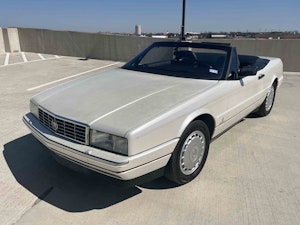Media | Articles
Adam Carolla, In His Own Words: How I Accidentally Started Collecting Paul Newman’s Race Cars
Adam Carolla has made several names for himself over his 25-year career in Hollywood: television and radio host, comedian, best-selling author, podcast pioneer, filmmaker, and race car driver. In recent years, the latter two roles have come together in the form of a pair of documentaries that delve into iconic—but underexplored—stories from the racing world, specifically Paul Newman’s life as a championship-winning driver and the legendary battles between Ford and Ferrari for victory at Le Mans in the 1960s.
Carolla and his producing partner, Nate Adams, are readying their third racing documentary for release, a profile of Willy T. Ribbs, the first African-American driver in the Indianapolis 500.
Not content to make films, Carolla and Adams recently launched Chassy.com, a channel dedicated to high-quality documentary content centered on cars, motorcycles, and anything else with an engine. In addition to his filmmaking pursuits, Carolla also helms the weekly CarCast podcast with longtime co-host Matt D’Andria.
We recently chatted with Carolla about these projects, as well his own car-collecting predilections and a recent foray into professional racing.
Marketplace
Buy and sell classics with confidence
Tell us about your evolution as a car collector and how you ended up with a garage full of Paul Newman race cars.
I like Japanese cars for some stupid reason. I had a 240Z back in the day. I had a Datsun 2000 roadster, and I just thought those were the coolest cars. I like the overhead cam. I like the straight configuration. I like the power they make.
When I started making some money and getting into vintage race cars, of course I went Japanese. Other people realized that I like Japanese vintage race cars, and so they would say, “There’s a 300ZX race car for sale. Do you want to buy it? Oh, and by the way, it was Paul Newman’s car.”
So I’d say, “OK, I’ll take it.”
Later on, another car would come up and the owner would say, “It’s a Japanese race car, and it was also Paul Newman’s car.”
And I’d say, “Well, OK. I’ll take it.”
I was basically just collecting Japanese and Datsun race cars, but they happened to have Newman’s name on them. At a certain point, I just thought, “Wait a minute, there is a theme emerging here. Maybe I should start getting more Newman-related stuff.”
And that’s how it became a thing.
Aside from your love of Japanese cars, what makes Paul Newman more fascinating to you than someone like Steve McQueen?
Newman seemed like a genuine humanitarian, and I like the idea of paying tribute to the humanitarian more than to the guy who would take swings at directors. I never knew either one of them personally, but I’ve just heard a few Steve McQueen stories that made him seem a little tough to get along with. I know a lot of Paul Newman stories and he seemed like a pretty genuine guy. So I like pulling for the nice guy. The McQueen stuff is really valuable because he was the bad boy, but I sort of like pulling for the nice guy. Oh, and the nice guy won four national championships driving a race car so it was no hobby.
How do you find stories, and how do you choose one project over another
We usually do a thing where, for example, we’re in the process of making the Newman documentary, sitting in an edit bay all day, and then we stumble onto Willy T. Ribbs and say, “Geez, this Willy T. Ribbs guy is a really interesting story.” Now we have our next documentary before we’re finished with the last one. At that same time, I was reading “Go Like Hell” by A.J. Baime and realizing that this is our next documentary, so we’re starting documentaries before the other ones are even finished.
When we started (making The 24 Hour War), I hadn’t known as much about the Ken Miles story as I probably should have. That part to me was eye-opening. Miles was such a gentleman and he was so mild-mannered. He was going to be the first guy to win the triple crown of Daytona, Sebring, and LeMans and basically just got gypped out of his LeMans win, only to die tragically in testing some months later—and all of this has just kind of been lost to the dustbin of history. It’s so sad that most people, even gearheads and people that are into the hobby, don’t even know who Ken Miles was.
Tell us about the Willy T. Ribbs story and what makes it such an attractive documentary subject.
It’s a really crazy story. There’s even a whole Bill Cosby part—Bill Cosby sponsored him! And speaking of people in the news: Bruce Jenner drove against him with Scott Pruitt’s team. Ribbs had a fierce rivalry with Pruitt—he even punched Pruitt—and Jenner was Pruitt’s driving partner. There’s only so much room on the hard drive in your brain for Willy T. Ribbs information, but by the time we’re done with this film you’re going to be a Willy T. Ribbs expert.
How was your recent foray into professional racing (in a Burtin Racing Corvette C7.R at Willow Springs Raceway)?
I know it sounds like something should’ve surprised me, but it was really just getting into a different car. The modern cars are more civilized. Not that they have a lot of creature comforts or anything; they are still just bad-ass-crazy race cars. This thing had something like 850 horsepower, massive slicks, and probably weighed 2,600 pounds. It’s a pretty beastly car, but it’s a modern race car, so it’s dialed in, and the brakes work, and the gauges are all in a digital cluster in front of me.
When I’d come off the track after practice, the crew would hook the computer up to the suspension. They might put a little more camber into it, or put a few more pounds of gas in one of the shocks to keep the rear end from moving around. I thought, “Oh, there’s a little science going on here!” With my vintage stuff you just sort of get into it and go.
So even though the Corvette had all the power, and Willow Springs is a very fast track, I still felt incredibly comfortable with it because the cars are so much more responsive and predictable. They’re just easier cars to drive. I guess I would say it’s the difference between a modern-day Corvette and a Corvette from the ’60s, except those are on the street.
I took third place in this race so that actually put me in the points for the season series. I kind of thought, “Well, if I have the points and I’m just getting used to the car, maybe I can do Portland or maybe I can do COTA…” But my schedule is a mess and I thought, “Who am I kidding?” I’m not going to quit working and join a professional racing circuit.










